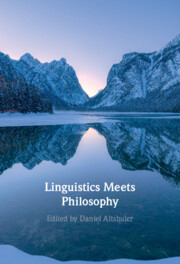Book contents
- Linguistics Meets Philosophy
- Linguistics Meets Philosophy
- Copyright page
- Contents
- Figures
- Tables
- Contributors
- Linguistics Meets Philosophy: A Historical Preface
- Introduction
- Part I Reporting and Ascribing
- Part II Describing and Referring
- Part III Narrating and Structuring
- Part IV Locating and Inferring
- Part V Typologizing and Ontologizing
- Part VI Determining and Questioning
- Part VII Arguing and Rejecting
- Part VIII Implying and (Pre)supposing
- Index
- References
Part III - Narrating and Structuring
Published online by Cambridge University Press: 06 October 2022
- Linguistics Meets Philosophy
- Linguistics Meets Philosophy
- Copyright page
- Contents
- Figures
- Tables
- Contributors
- Linguistics Meets Philosophy: A Historical Preface
- Introduction
- Part I Reporting and Ascribing
- Part II Describing and Referring
- Part III Narrating and Structuring
- Part IV Locating and Inferring
- Part V Typologizing and Ontologizing
- Part VI Determining and Questioning
- Part VII Arguing and Rejecting
- Part VIII Implying and (Pre)supposing
- Index
- References
Summary

- Type
- Chapter
- Information
- Linguistics Meets Philosophy , pp. 137 - 214Publisher: Cambridge University PressPrint publication year: 2022

